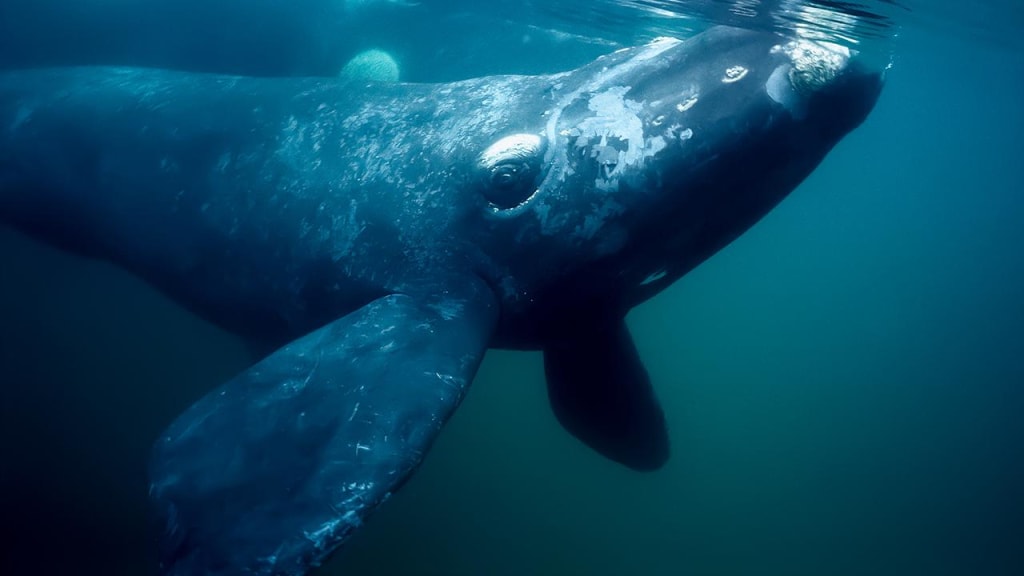Six Facts About the North Atlantic Right Whale
Get to know one of the most endangered whales on Earth.

The North Atlantic Right Whale (Eubalaena glacialis) is regarded as one of the most endangered species of baleen whales in the world. The species has a very long history of being subjected to human exploitation until the 1930s when laws were finally passed to protect the slow-moving marine mammals from the whaling industry. Yet, despite these efforts, the population in the North Atlantic shows very little to no signs of recovery. So, here are six things to know about these endangered mammals.
1. They were among the first of the “great whales” to be hunted by commercial whalers.
As slow-moving and being rich in blubber, the right whale was dubbed as the “right” whale to hunt by 19th century whalers. This is because right whales, being slow-moving mammals, were very easy for the whalers the hunt down. Once the whales were hunted, their carcasses would easily start to float. In addition, they were also known to swim and feed close to shore and the surface of the water as well. They were hunted for large quantities of oil and baleen.
2. They don’t refer to them as “great whales” for nothing.
North Atlantic right whales are large and robust. An adult right whale can grow up to 50 feet long and weight up to 60 tons. At birth, calves can be long as 15 feet in length and weight up to 2,000 pounds after an 11-month gestation period. These whales can easily be recognizable among the “great whales” by their lack of dorsal fin, square chin and have highly arched upper jaws that have distinctive callosities, which are thickened patches of skin on their rostrums that found behind their blowholes, over their eyes, on the corners of their chins, and along their lower jaws.
3. They are slow swimmers.
Although right whales can dive for about 10-20 minutes at a time, they only swim about 3-7 miles per hour. Consequently, this makes the animals more vulnerable to boat strikes all across the New England coast and the Canadian Maritimes, which is why in the United States alone, all boats are required to stay at least 500 yards away from approaching right whales.
4. They are found exclusively in the North Atlantic.
The North Atlantic Right Whale ranges from Nova Scotia to Cape Cod during the spring and summer months and the Florida-Georgia border during the Winter months. It’s believed that the whales spend their winter months in Florida-Georgia border to breed and have their calves while returning to waters off New England Canada to feed. On some occasions, right whales might be spotted along the coast of Newfoundland and the Gulf of St. Lawrence. There were once a thriving population in waters off of Norway, The British Isles, Iceland, France, and Spain, However, due to centuries of whaling in European waters, which goes back to Roman times, right whales are now considered to be a rare sight in European waters.
5. They are solitary animals.
Like all baleen whale species, right whales are mainly solitary animals. However, they do occur in small groups that are often short-lived. During the breeding season, courtship groups may consist of 3 to 30 animals that involve multiple males jostling for position around the females. These interactions involve rolling and churning. However, the main long-term social bond between right whales are usually between mothers and calves. From the time they are born, to the time they are a year old, calves will learn from their mothers on how to become independent.
6. They are known as the Official State Marine Mammal of Massachusetts.
Since 1980, the North Atlantic Right Whale has been regarded as Massachusetts’ official state marine mammal. This is because their status as being “endangered” and their seasonal presence in Cape Cod waters has enabled the state to establish critical habitats for right whales that rely on Cape Cod Bay and the Great South Channel for feeding on the plankton that is brought up by upwelling currents and to raise their calves during their first year of life. With only 450 animals left in the world, and a very low reproductive rate, the state of Massachusetts continues to its ongoing efforts to protect right whales through funding research programs that are aimed at documenting them and raising public awareness about their plight.
Thank you very much for reading up on the North Atlantic Right Whale, if you like this story and my other stories on Vocal, please feel free to send me a tip. If you like to make a request on what I should write about, feel free to contribute on Patreon for as little as a dollar a month. Anyway, thank you for reading.
About the Creator
Jenna Deedy
Zoo and Aquarium Professional, Educator, Cosplayer, Writer and B.A. in Psychology whose got a lot to share when it comes to animals, zoos, aquariums, conservation, and more.
Instagram: @jennacostadeedy






Comments
There are no comments for this story
Be the first to respond and start the conversation.